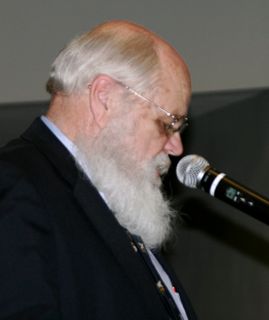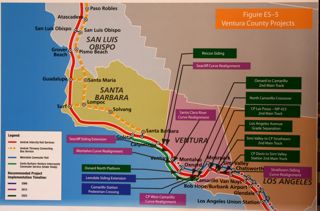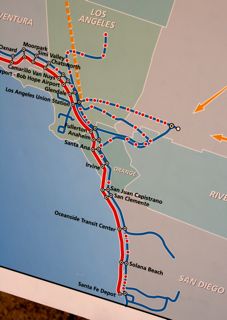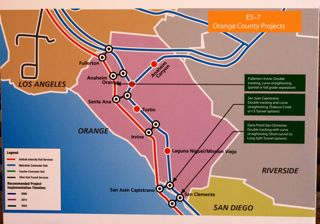
Mr. Brown read from the 29-page "
LOSSAN Rail Corridor
Agency Fact Sheet" and "
LOSSAN Corridor
Strategic Business Plan - Making Progress - Advancing Mobility.
December 2007." (LOSSAN is Los Angeles, San Diego, San
Luis Obispo Rail Corridor Agency).
I took a few notes, and when Mr. Brown was done speaking, I asked if
his information was online so I could fact check my story. He
handed me the booklet from which he was reading!
Here's what I gleaned from the booklet:
About LOSSAN
... works to increase ridership, revenue, capacity, reliability, and
safety on the coastal rail line from San Diego to Los Angeles to San
Luis Obispo. The LOSSAN rail corridor is second only to the
Northeast corridor. It parallels Interstate 5 and Highway 101,
both of which are heavily congested. Also knows as Amtrak's Pacific Surfliner corridor,
this 351-mile rail line serves more than
2.7 million intercity passengers and 4.5 million passengers on the Metrolink and Coaster systems. One in every nine Amtrak riders use
this corridor.
... four critical improvement projects: grade separations in
FUllerton, Commerce, and Solana Beach and bluff stabilization in Del
Mar, funded by the Federal Transit Administration's New Starts program.
Critical projects: centralized traffic control systems, double
and triple tracking, siding extensions, station parking structures,
real-time passenger information systems, bridge replacements, and grade
crossing safety improvements.
LOSSAN
Corridor Strategic Business Plan
(You
might find the entire report online by searching by this title)
BNSF and UP freight service also uses this corridor, predominantly from
the Ports of LA and Long Beach. Forty percent of the corridor
remains single track.
This corridor goes through six counties and some of the most scenic and
environmentally sensitive areas in the state and is located for
extended stretches directly adjacent to the Pacific Ocean (ES-1 below).
Built in the latter portion of the 19th century and early 20th century,
today's expansion of the corridor is limited. The northern
section is 80% single-tracked and the Los Angeles to San Diego section
is 41% single-tracked. There are locations in the UP-owned
northern portion which have jointed track rather than
continuously-welded rail, older signaling systems which require trains
to wait for dispatcher approval by radio in order to advance, and
hand-thrown switches' rather than electrically-operated switches (also
called turnouts). Long stretches of single-track and relatively
short sidings require passenger trains to wait for longer freight
trains to clear a section before continuing.
Track Speeds in San Diego County.
NCTD maintains the railroad to
Class V operations which allow for maximum passenger train speeds of 90
miles per hour.
Track Speeds in Orange County.
Track and signal conditions in
Orange County are generally FRA Class IV, with maximum speeds of 79 mph
for passenger rail and 50 mph for freight, though there are stretches
of 90 mph track for passenger rail and 55 mph for freight particularly
between San Juan Capistrano and Santa Ana.
Current and Future Train Volumes
(selected)
Amtrak:
Coast Starlight (LA - SLO) Two through 2025.
Coast
Daylight [Proposed] (LA - San Francisco) Two by 2015,
Four by 2025.
Pacific
Surfliner (North: LA - Goleta) Now 10, 2015 -
12, 2025 - 14.
Pacific
Surfliner (North: Goleta - SLO) Now 4, 2015 -
6, 2025 - 32.
Pacific
Surfliner (South: LA - San Diego) Now 22, 2015 -
26, 2025 - 32.
Southwest
Chief (LA - Fullerton) Now 2 and 2 through 2025.
Metrolink All routes
more than double by 2015, except between Laguna Niguel and Oceanside
remains at 10.
COASTER (Oceanside - San
Diego) More than double by 2025, from 22 currently.
Proposed: Ventura-Santa Barbara
Commuter Rail None in 2006, 6 in 2015 to 8 in 2025
Freight Services:
UP (North of LA) 2006 -
4, 2015 - 6, 2025 - 8.
BNSF (LA - Fullerton) 2006 - 75, 2025 - 99.
BNSF (Fullerton - San Diego) 2006 - 6 to 8, 2025 - 9 to 12.
Summary of all
Trains increase over 2005:
2015 +49, 2025 +252.
RAIL IMPROVEMENT
PROJECTS (Selected):
Intermediate - completed within 1 to
3 years.
Near-term - completed within 4 to 8
years.
Vision - completed within 9 to 20
years.
Los
Angeles County:
Union Station
run-Through Tracks - Near- Term $640M
San
Diego County:
Camp Pendleton -
Double Tracking - Immediate - $39M
Del Mar - Camino Del Mar Tunnel option - Vision - $365M
Del Mar - Penasquitos Lagoon Bypass Tunnel option - Vision - $560M
Early Action
Projects - Ready To Go
(Selected):
LA-Fullerton Triple Track, LAUS
Station Track, Fullerton Parking Structure, Placentia Avenue.
As I said above, you might find the entire report online under: LOSSAN
Corridor Strategic Business Plan, Making Progress Advancing Mobility,
December 2007.
Dan
Feger, P.E. Executive Director,
Burbank Bob Hope Airport
 Mr. Brown read from the 29-page "LOSSAN Rail Corridor
Agency Fact Sheet" and "LOSSAN Corridor
Strategic Business Plan - Making Progress - Advancing Mobility.
December 2007." (LOSSAN is Los Angeles, San Diego, San
Luis Obispo Rail Corridor Agency).
Mr. Brown read from the 29-page "LOSSAN Rail Corridor
Agency Fact Sheet" and "LOSSAN Corridor
Strategic Business Plan - Making Progress - Advancing Mobility.
December 2007." (LOSSAN is Los Angeles, San Diego, San
Luis Obispo Rail Corridor Agency).




